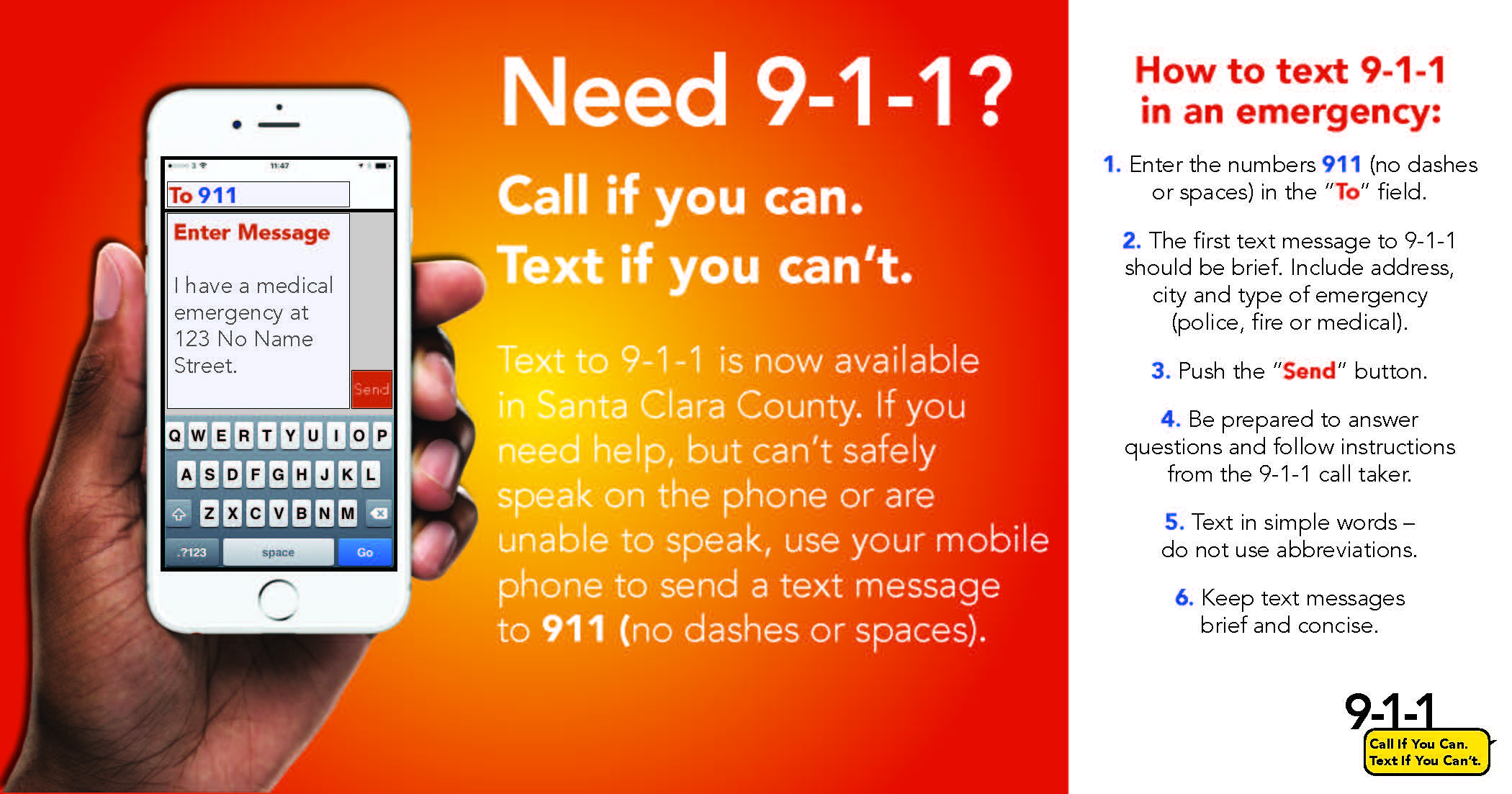9-1-1 EMERGENCY
9-1-1 is recognized as the nationwide emergency telephone number.
Santa Clara County has an Enhanced 9-1-1 or E9-1-1 system that automatically displays the telephone number, address and name for which the phone is listed if the call is made from a wireline or “landline” telephone. If the caller is unable to remain on the line, unable to speak or if the call is disconnected, the dispatcher (call taker) can still obtain enough information to send help. Some 9-1-1 systems can reconnect a caller and transfer callers to other agencies or telephone numbers with a single button.
How to Report Emergencies
- Dial 9-1-1.
- Speak slowly and clearly. Remain calm.
- State your name, location of the emergency and telephone number.
- Provide as much information as possible.
- Stay on the telephone, answer all questions asked, and follow any instructions that the 9-1-1 dispatcher may give.
WHERE? Where are you located? Provide address or location information.
WHAT? What happened?
WHO? Who is involved? Is anyone hurt?
WHEN? When did it happen? Is the emergency going on right now?
WHY? Remain on the phone, dispatcher will ask follow-up questions.
9-1-1 Safety Tips
Stay on the line.
Your call will be answered as soon as possible.
Do have any information available.
Write it down if necessary.
Do let the dispatcher ask the questions.
The dispatcher will determine how to best help you.
Do stay on the line as long as needed.
The dispatcher may need to update information.
Text to 9-1-1
Text to 9-1-1 is the ability to send a text message to 9-1-1 from your mobile phone or handheld device. Voice calls are still the best and fastes tway to contact 9-1-1. Text to 9-1-1 is ONLY recommended when a voice call is NOT possible.
Can I Text to 9-1-1 in Santa Clara County?
- Text to 9-1-1 is not available everywhere and is not always available when roaming.
- Text to 9-1-1 is currently available in the unincorporated areas of Santa Clara County, and the cities of Cupertino, Gilroy, Los Altos, Los Altos Hills, Milpitas, Monte Sereno, Mountain View, Palo Alto, San Jose, Santa Clara, Saratoga and Sunnyvale. The cities of Campbell and Los Gatos are expected to offer the service by the end of 2019.
- You must subscribe to your wireless carrier’s text or data plan in order to send or receive text messages.
- If Text to 9-1-1 is not available in your area, or is temporarily unavailable, you should receive a message indicating that Text to 9-1-1 is not available and to contact 9-1-1 by other means.
When should I text 9-1-1?
- Dialing 9-1-1 in an emergency is still the preferred way to request help, and the public is reminded to “Call if you can. Text if you can’t.”
- ONLY text 9-1-1 in an emergency. Prank-texters can be identified and possibly prosecuted according to local laws/regulations.
- Text to 9-1-1 is intended primarily for use in three emergency scenarios:
1. For an individual who is deaf, hard-of-hearing or has a speech disability.
2. For someone who is in a situation where it is not safe to place a voice call to 9-1-1.
3. A medical emergency that renders the person incapable of speech.
Text-to-9-1-1 Tips
How do I text to 9-1-1?
- Enter the numbers “911” in the “To” or “Recipient” field.
- The first text to 9-1-1 should be short, include the location of the emergency, and ask for police, fire or ambulance.
- Push the “Send” button.
- Answer questions and follow instructions from the 9-1-1 call taker.
- Text in simple words –no abbreviations or slang.
- Keep text messages short.
How will I know if 9-1-1 received my text?
- A 9-1-1 call center should respond to the text.
- If Text to 9-1-1 is not available, you should receive a message from the wireless carrier stating that Text to 9-1-1 is not available and that you must place a voice or relay call to 9-1-1.
Is there a charge to text-to-9-1-1?
- Standard text messaging rates apply.
Telephone Tips for Emergencies Brochure

